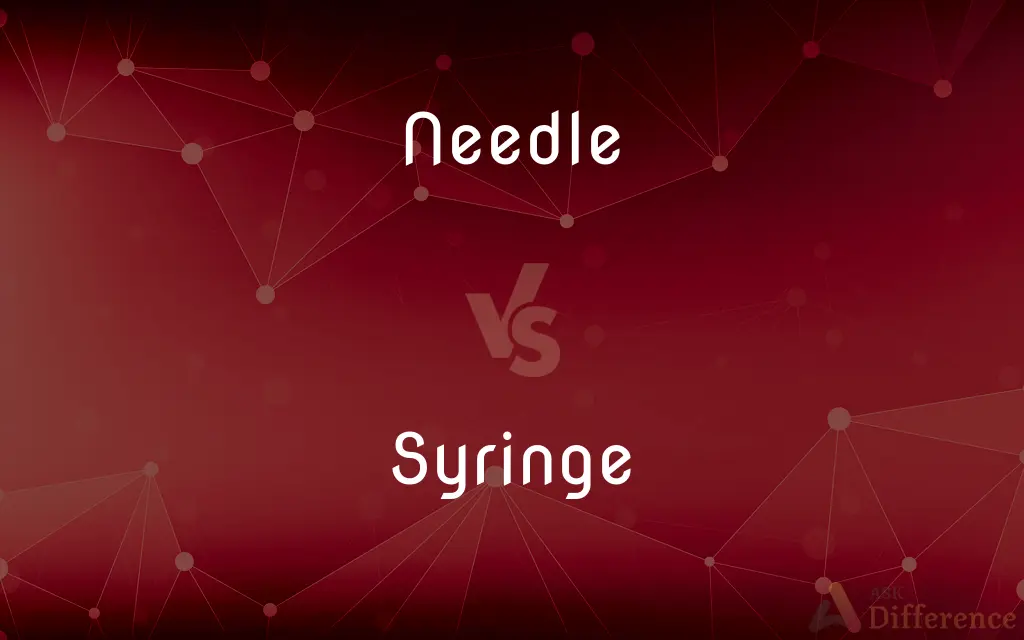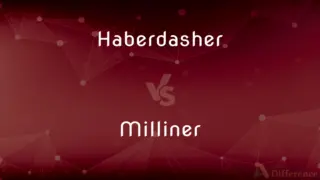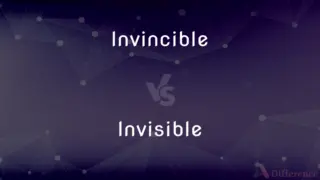Needle vs. Syringe — What's the Difference?
By Tayyaba Rehman & Urooj Arif — Updated on April 19, 2024
A needle is a slender, pointed metal instrument for piercing, while a syringe is a device that uses a plunger to draw in or expel liquid through the needle.

Difference Between Needle and Syringe
Table of Contents
ADVERTISEMENT
Key Differences
A needle is primarily designed to pierce or penetrate materials, often used in medical applications to inject substances into the body. Whereas a syringe is a medical device that includes a hollow cylinder equipped with a plunger used to inject or withdraw fluids from the body.
The needle itself is just one component, typically made of metal and very sharp, used for its ability to access tightly controlled spaces in the body. On the other hand, the syringe includes both the needle and a chamber (the barrel), which holds the fluid to be administered or drawn.
Needles come in various sizes and gauges depending on their specific uses, such as drawing blood or administering vaccines. Whereas syringes also vary in size, primarily based on the volume of fluid they are designed to handle, such as insulin syringes which are typically smaller.
In terms of operation, a needle alone has no mechanism to draw in or expel substances; it must be attached to a syringe or other device. On the other hand, a syringe's functionality comes from its plunger, which allows control over the fluid entering or leaving the syringe through the needle.
While needles are often associated with medical use, they are also utilized in other fields such as tattooing and sewing. In contrast, syringes are almost exclusively used in medical contexts or precise applications like scientific research where measurement and control of liquid substances are required.
ADVERTISEMENT
Comparison Chart
Composition
Metal, usually stainless steel
Plastic or glass barrel, rubber plunger
Function
To pierce or penetrate
To inject or draw fluids
Variability
Size and gauge
Size and capacity
Operational Need
Requires a device to function
Self-sufficient with a plunger
Use Context
Medical, sewing, tattooing
Medical, scientific research
Compare with Definitions
Needle
A small, slender, pointed piece of metal used to sew or puncture.
She threaded the needle carefully before beginning to sew.
Syringe
A tool used to draw fluids from the body.
The lab technician used a syringe to collect a blood sample.
Needle
A component of a turntable that reads vinyl records.
He replaced the old needle to improve the sound quality.
Syringe
A precise instrument used in scientific experiments.
He measured the chemical precisely using a syringe.
Needle
A sharp metal spike used for acupuncture.
The therapist placed several needles along the patient’s back.
Syringe
A device in culinary uses for injecting flavors.
She used a syringe to inject marinade into the meat.
Needle
An instrument used to indicate measurements on dials.
The needle on the fuel gauge showed that the tank was nearly empty.
Syringe
A medical instrument used to inject fluids into the body.
The nurse prepared a syringe for the injection.
Needle
A device used in medical settings to administer injections.
The doctor used a needle to administer the vaccine.
Syringe
An oral syringe used to administer medications.
The mother used an oral syringe to give medicine to her child.
Needle
A slender, pointed implement used for sewing or surgical suturing, made usually of polished steel and having an eye at one end through which a length of thread is passed and held.
Syringe
A syringe is a simple reciprocating pump consisting of a plunger (though in modern syringes, it is actually a piston) that fits tightly within a cylindrical tube called a barrel. The plunger can be linearly pulled and pushed along the inside of the tube, allowing the syringe to take in and expel liquid or gas through a discharge orifice at the front (open) end of the tube.
Needle
Any of various similar implements, such as a fine sharp-pointed instrument used in acupuncture or a pointed shaft used in knitting, crocheting, or lace making.
Syringe
A medical instrument used to inject fluids into the body or draw them from it.
Needle
A sharp-pointed instrument used in engraving.
Syringe
A hypodermic syringe.
Needle
A slender piece of jewel or steel used to transmit vibrations from the grooves of a phonograph record.
Syringe
A device used for injecting or drawing fluids through a membrane.
Needle
A slender pointer or indicator on a dial, scale, or similar part of a mechanical device.
Syringe
A device consisting of a hypodermic needle, a chamber for containing liquids, and a piston for applying pressure (to inject) or reducing pressure (to draw); a hypodermic syringe.
Needle
A magnetic needle.
Syringe
To clean or rinse by means of a syringe.
Have your ears syringed! They're so dirty!
Needle
A hypodermic needle.
Syringe
To inject by means of a syringe.
Needle
(Informal) A hypodermic injection; a shot.
Syringe
A kind of small hand-pump for throwing a stream of liquid, or for purposes of aspiration. It consists of a small cylindrical barrel and piston, or a bulb of soft elastic material, with or without valves, and with a nozzle which is sometimes at the end of a flexible tube; - used for injecting animal bodies, cleansing wounds, etc.
Needle
Chiefly Upper Northern US See dragonfly.
Syringe
To inject by means of a syringe; as, to syringe warm water into a vein.
Needle
A narrow stiff leaf, as of a pine or fir.
Syringe
To wash and clean by injection from a syringe.
Needle
A fine, sharp projection, as a spine of a sea urchin or a crystal.
Syringe
A medical instrument used to inject or withdraw fluids
Needle
A tall narrow rock formation.
Syringe
Spray or irrigate (a body part) with a syringe
Needle
An obelisk.
Needle
(Informal) A goading, provoking, or teasing remark or act.
Needle
To prick, pierce, or stitch with a needle.
Needle
(Informal) To goad, provoke, or tease.
Needle
To sew or do similar work with a needle.
Needle
A long, thin, sharp implement usually for piercing as in sewing, embroidery, acupuncture, tattooing, body piercing, medical injections, sutures, etc; or a blunt but otherwise similar implement used for forming loops or knots in crafts such as darning, knitting, tatting, etc.
The seamstress threaded the needle to sew on a button.
Reusable needles
Single-use needles
Needle
Any slender, pointed object resembling a needle, such as a pointed crystal, a sharp pinnacle of rock, an obelisk, etc.
Needle
A fine measurement indicator on a dial or graph.
A compass needle
The needle on the fuel gauge pointed to empty.
Needle
(informal) A sensor for playing phonograph records, a phonograph stylus.
Ziggy bought some diamond needles for his hi-fi phonograph.
Needle
A needle-like leaf found on some conifers.
Needle
A strong beam resting on props, used as a temporary support during building repairs.
Needle
(programming) A text string that is searched for within another string. (see: needle in a haystack)
Needle
(entomology) Any of various species of damselfly of the genus Synlestes, endemic to Australia.
Needle
To pierce with a needle, especially for sewing or acupuncture.
Needle
(transitive) To tease in order to provoke; to poke fun at.
Billy needled his sister incessantly about her pimples.
Needle
(ambitransitive) To form, or be formed, in the shape of a needle.
To needle crystals
Needle
A small instrument of steel, sharply pointed at one end, with an eye to receive a thread, - used in sewing.
Needle
See Magnetic needle, under Magnetic.
Needle
A slender rod or wire used in knitting; a knitting needle; also, a hooked instrument which carries the thread or twine, and by means of which knots or loops are formed in the process of netting, knitting, or crocheting.
Needle
One of the needle-shaped secondary leaves of pine trees. See Pinus.
Needle
Any slender, pointed object, like a needle, as a pointed crystal, a sharp pinnacle of rock, an obelisk, etc.
Needle
A hypodermic needle; a syringe fitted with a hypodermic needle, used for injecting fluids into the body.
Needle
An injection of medicine from a hypodermic needle; a shot.
Needle
To form in the shape of a needle; as, to needle crystals.
Needle
To tease (a person), especially repeatedly.
Needle
To prod or goad (someone) into action by teasing or daring.
Needle
To form needles; to crystallize in the form of needles.
Needle
As of a conifer
Needle
A slender pointer for indicating the reading on the scale of a measuring instrument
Needle
A sharp pointed implement (usually steel)
Needle
A stylus that formerly made sound by following a groove in a phonograph record
Needle
Goad or provoke,as by constant criticism;
He needled her with his sarcastic remarks
Needle
Prick with a needle
Common Curiosities
How does a syringe work?
A syringe works by using a plunger to draw in or expel liquid through a needle attached to its tip.
What materials are needles made of?
Needles are usually made of stainless steel for durability and hygiene.
What is a needle used for?
A needle is used for piercing, sewing, or medical injections.
Are syringes reusable?
Some syringes, particularly those made of glass, are designed to be reusable, while many plastic syringes are intended for single use.
What sizes do needles come in?
Needles come in different sizes and gauges, depending on their specific application.
What is the difference between a needle and a syringe in terms of cost?
Generally, syringes are more costly than needles due to their more complex structure and functionality.
How are needles disposed of safely?
Needles should be disposed of in designated sharps containers to prevent needle-stick injuries.
Can a needle be used without a syringe?
In medical applications, a needle generally cannot be used without a syringe or other device to administer or withdraw fluids.
How is a syringe sterilized?
Syringes are sterilized using methods such as autoclaving, gamma radiation, or ethylene oxide gas.
What types of syringes are there?
There are various types of syringes including insulin syringes, tuberculin syringes, and oral syringes.
Can syringes be used for purposes other than medical?
Yes, syringes can be used in scientific research and culinary applications to measure and inject precise amounts of liquids.
What is the environmental impact of syringes?
Disposable syringes contribute to medical waste, which needs careful handling to mitigate environmental impact.
What safety features do modern syringes have?
Many modern syringes come with safety features like retractable needles or needle covers to prevent accidental injuries.
How do needle gauges affect usage?
The gauge of a needle affects its diameter; lower gauges are thicker and used for substances like blood, while higher gauges are thinner and used for vaccines.
Are there alternatives to needles for drug delivery?
Yes, alternatives like transdermal patches and nasal sprays are used for drug delivery without using needles.
Share Your Discovery

Previous Comparison
Haberdasher vs. Milliner
Next Comparison
Invincible vs. InvisibleAuthor Spotlight
Written by
Tayyaba RehmanTayyaba Rehman is a distinguished writer, currently serving as a primary contributor to askdifference.com. As a researcher in semantics and etymology, Tayyaba's passion for the complexity of languages and their distinctions has found a perfect home on the platform. Tayyaba delves into the intricacies of language, distinguishing between commonly confused words and phrases, thereby providing clarity for readers worldwide.
Co-written by
Urooj ArifUrooj is a skilled content writer at Ask Difference, known for her exceptional ability to simplify complex topics into engaging and informative content. With a passion for research and a flair for clear, concise writing, she consistently delivers articles that resonate with our diverse audience.














































